City of trees
review by Alison Wishart
I thought the National Library of Australia had backed a sure winner with its latest exhibition, City of Trees. Trees are something everyone has interacted with: whether you’ve kicked piles of autumn leaves, sought their shade in summer or climbed one in the school yard. Trees are ubiquitous in Canberra – the exhibition title rings true. So why did this exhibition leave me feeling flat and disappointed?
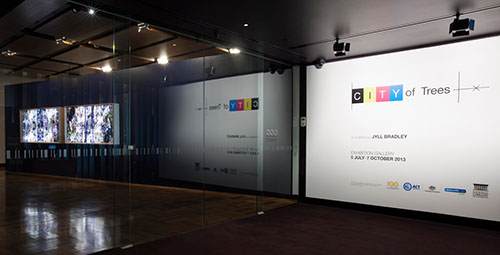
photograph by Lannon Harley
City of Trees is made of six content elements. Firstly, as you walk into the exhibition, there are two light boxes, beautifully constructed from wood, with large, backlit photographs taken by the British artist and curator of the exhibition, Jyll Bradley. The colour photos show sunlight pushing through a dense collection of tree trunks, branches and leaves. There are several photographs layered on top of each other and some are upside down – why? Is it intended to make me look twice at the photo, or a sign of the artist’s playfulness? Is this meant to tell me something profound that I missed? Perhaps I should have seen this as a sign that I was about to experience a contemporary art exhibition rather than a social history exhibition.
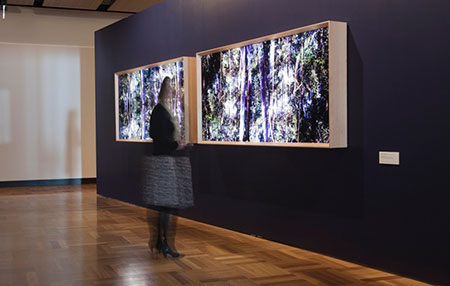
photograph by Lannon Harley
Rounding the corner, I encountered the second content component: a wall of framed photographs presented as a collage of archival photos and ones taken by the artist. The photographs are printed on scatter proof paper, which I’m told in a label is used by printers to check the colour before the photos are printed in a publication. The archival photos have no interpretive labels and assume a high level of knowledge from the audience – we are supposed to recognise the forestry students, the Canberra sites from the 1920s, Walter Burley Griffin and Marion Mahony Griffin (and know their roles in the design of Canberra) and the contemporary vistas of trees (some of which are again upside down and sideways). The lack of individual labels for the photographs makes me think that the artist–curator wanted to give the audience a sense of the history of the ‘city of trees’, rather than informing the audience about how it developed. For me as a social history curator, this was a missed learning opportunity. However, I did particularly like the photographs of a shed, showing a vast array of garden tools, nets and stakes which (I assume) are used to maintain and grow trees. These photos question the assumption that trees grow easily and unaided.
Next I came to the most esoteric component of the exhibition. Bradley has used sheets of blotting paper donated by the Yarralumla Nursery as the canvas for her own artworks. The blotting paper was originally used to press leaves and flowers and some still contain their impressions. Bradley has worked with these reliefs and ‘drawn’ (using a photocopier) abstract lines and circles and miniature people over the top of them. I warmed to the romance of taking old pieces of paper from the Yarralumla Nursery, which provided most of the trees for Canberra’s parks and avenues, and recycling and repurposing them as canvases. These artworks are collectively labelled: ‘architecture makes form; trees make space’. I really liked the idea presented in this quotation, but, for me, the artworks failed to elaborate on this. Once again, I was left feeling confused and disappointed. Another missed learning opportunity.
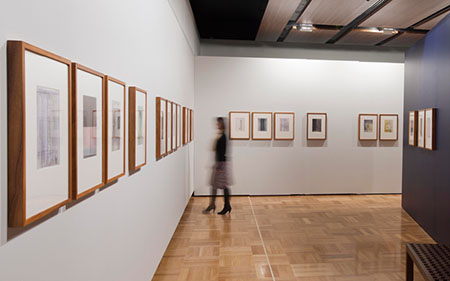
photograph by Lannon Harley
Circling back, I went into the fourth exhibition component: one of the three big sound cones that dominate the exhibition space. These are cleverly constructed from beige cardboard and according to the room brochure are either ‘standing like tree trunks in a clearing, [or] curl like a leaf to enclose listeners’. I’m not sure if this is what the exhibition designer (Isobel Trundle) had in mind. To me, they resembled truncated smoke stacks reminiscent of pulp mills. This could have been an opportunity to make even a subtle, sideways comment on the woodchip-paper industry and how it could destroy the trees we are celebrating, but, contrary to the claim to be political in the introductory panel, the exhibition shies away from politics.
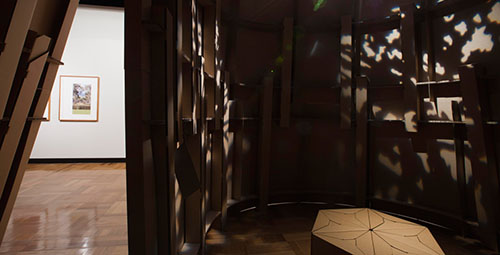
photograph by Lannon Harley
Inside the cardboard cones there is enough space for only two to three people to sit and listen to audio recordings which are between 20 and 30 minutes in length. There was nothing to look at while listening to the recordings and the uncomfortable seats didn’t encourage visitors to stay and listen. I think this is a major flaw of the exhibition. The Library’s website describes these sound recordings as ‘the centrepiece of the exhibition … where visitors can listen to the stories and thoughts of the myriad of people in Canberra and the region for whom trees are a passion, profession or a way of life’. So why not design the sound portals in such a way that they entice visitors to stop and listen? This could be achieved by turning the giant sound portals inside out so that the smooth surface was on the inside and could be used for projections. I really wanted to see a photo of the remnant of a eucalypt tree in Franklin (a new Canberra suburb) that 14 people were asked to comment on during a 20-minute audio piece. Another audio-work is about the National Arboretum Canberra, the collection of living trees being established at the western end of Lake Burley Griffin. It would have been great to see some images of this space in the sound portal, and would have significantly enhanced my appreciation of the audio content and my learning experience. Slide shows or projections may be considered passé by some, but if they aid understanding and engagement and entice visitors to stay in the exhibition, then surely that more than counteracts their ‘uncool-ness’? Fortunately, in this digital age, I was able later to download the audio files and listen as I walked among Canberra’s trees – an experience I would recommend.
The fifth content component is on the reverse side of the opening exhibition wall, like the verso page of a book. It is a row of cardboard sheets hung at an angle, each with a poem about trees. The poems are presented with egalitarian elegance, so that Les Murray’s efficient and evocative poem is given the same status as those by less well-known poets. The row of poems reminded me of rows in a pine plantation, or the rows of fir trees in Canberra’s Haig Park – perhaps another missed opportunity to talk about the relationship between paper and trees.
The sixth, and, I think, the most powerful component of the exhibition is the space where visitors are encouraged to share their own tree stories. There are two beautiful ‘memory books’ with handmade paper for people to ‘record a tree memory’. When I visited the exhibition 10 days after it had opened, every page of the two 56-page books had a story or drawing on it – a testimony to the power and ubiquity of trees in people’s lives. When I visited the exhibition again, a month after it had opened, new memory books were in place. I spent more time in this section of the exhibition reading the personal stories of trees than in any other section. One could argue that the rest of the exhibition created the space and opportunity for visitors to share their tree memories. Bradley’s story about how trees came into her life through her father, a veteran of the Second World War who returned within six months with a bad case of ‘nerves’, was particularly poignant. I wanted to hear more of his story and the impact that trees had in healing his life.
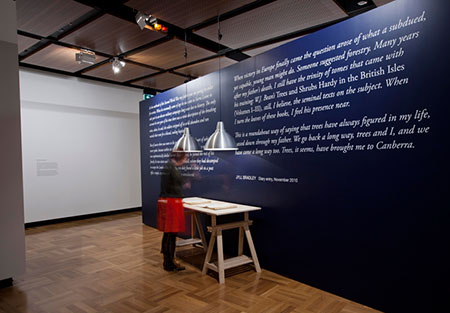
photograph by Lannon Harley
The six content components of City of Trees are woven together with a design that is coherent and minimalist. It doesn’t compete with the artworks in any way. The intent of the exhibition design seems to be to allow the artworks, whether they are photographs, audio interviews or poetry, to speak for themselves. I hoped there would be a label telling me that all the exhibition furnishings, frames, posters and room brochures were made from recycled cardboard, paper and wood, since it would have taken a tree or two to create them if not, but, ironically, there was none.
I expected much more from this exhibition. The avenues of exotic tree plantings, fruit groves in backyards, and green belts like Haig Park: these are some of the things that make Canberra a ‘city of trees’, but they were absent from this exhibition. Trees are a sensory experience; but there was no bark to touch, no eucalypt leaves to smell nor deciduous oak leaves to crunch. Bradley states that ‘trees are a door or portal leading to an understanding of Canberra and the people who live and work here’. This may be true, but her artworks and the way they were curated for the exhibition failed to reveal this. The sound recordings were informative and thought-provoking, but the exhibition design did not encourage visitors to stay and listen to them.
Bradley’s City of Trees was a free exhibition funded by and part of the Centenary of Canberra celebrations. I kept thinking how different this exhibition would be if it was prepared by a curator, who could mine the rich archives of the Library for ‘tree stories’ and work collaboratively with an artist. Robyn Archer, Director of the Centenary of Canberra, wanted Bradley for this project and commissioned her in 2010. It seems curious to choose an overseas artist when there are many talented Australians – like Peter Solness (photographer and author of Tree Stories) and Jeannie Baker (with her tiny tree collages), who might have contributed to this type of exhibition. Several visitors commented in the visitors’ book that they thought Bradley was an ‘inappropriate’ choice and evidence of the Australian cultural cringe.
Judging by other comments in the visitors’ book, this exhibition has polarised visitors. One visitor wrote: ‘DISAPPOINTING! Not value for our money!’ (no emphasis added ). Another wrote: ‘Waste of money, expected to be much better!’ and on the same page: ‘It’s fabulous! – wonderful showcase for trees of ACT’, and, ‘I “felt” the message, thank you’. The use of cardboard for much of the exhibition fit-out deterred a visitor who wrote: ‘I tried not to sneeze here’.
In City of Trees, the Library departed from the main reason cultural institutions have exhibitions: to interpret and provide access to their collections. Instead, they have showcased the work of a non-Australian artist. The Library appears to have turned its back on its own collections, and moved into the genre of contemporary art, an area that is well served by its neighbours, the National Portrait Gallery and the National Gallery of Australia. The memory books and audio recordings from the exhibition will come into the Library’s collection, but it’s uncertain whether the other artworks will remain in Canberra.
As I’ve outlined above, I believe the exhibition has several intrinsic problems. It is a rich topic for an exhibition but misses many learning opportunities. However, perhaps its biggest problem is living up to the expectations created in an article in the Library’s own magazine (June 2013 edition): ‘City of Trees is a place to listen and look, a place to reflect and remember and to know who we are and where we come from’. Canberra is a city of trees, but this exhibition doesn’t do it justice.
Alison Wishart is senior curator of photographs at the Australian War Memorial and a frequent visitor to the National Library of Australia.
| Exhibition: | City of Trees |
| Institution: | National Library of Australia |
| Curator: | Jyll Bradley, artist, with audio works by Jonquil Painting |
| Venue/dates: |
National Library of Australia, Canberra, 5 July – 7 October 2013 |
| Floor area: | 400 square metres |
| Exhibition websites: |
http://www.nla.gov.au/exhibitions/city-of-trees |
